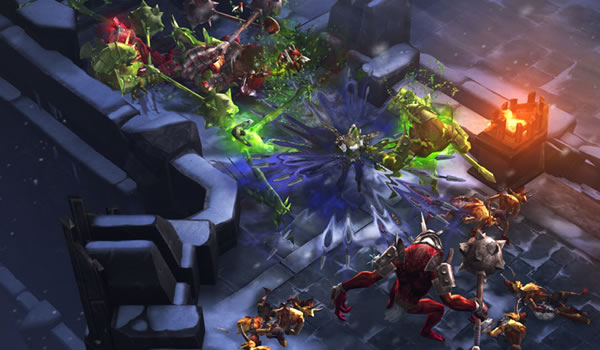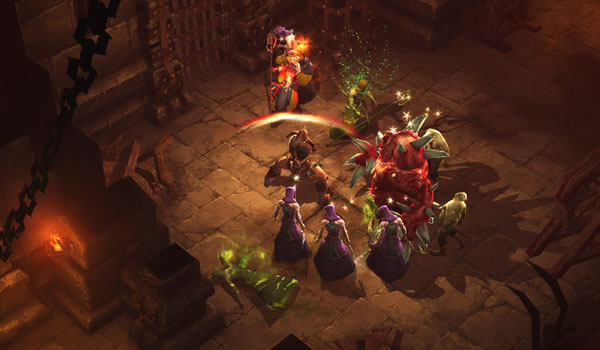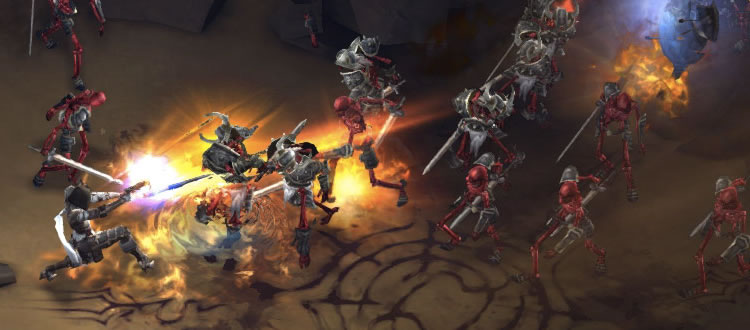Plagued with disconnects and shot through with lag, the May 15 launch of Diablo III had players and press alike railing against the always-online nature of the latest entry in the genre-defining action role-playing series. While not entirely unexpected, those unfortunate events punctuated the problems with requiring constant external server access for a single-player game.
And I was right there with everyone else, cursing Blizzard for imposing its online agenda on players. How dare they take an experience I've always been able to enjoy offline and force me to bow to the whims of external technology? It's unconscionable! It's intolerable!
It's quite brilliant.
Diablo III is a mouse drive-action game that sees the player take on the role of one of five characters tasked with saving the world from being overrun by the forces of evil. Humanity cowers in the shadow of ever-growing darkness, their only hope for salvation a player more engaged with collecting magical equipment and earning experience points than any noble quest.
As I type this I have the game sitting idle on my laptop, suspenseful orchestral music somehow managing to please despite being trapped in the tinny prison of portable PC speakers. My level 34 Demon Hunter stares out from the screen, resplendent in her hard-earned metal armor and high heels. Her steely gaze is fixed on me, but I'm not staring back.
I'm watching the bottom left corner of the screen. The achievements earned by people on my friend list scroll by. When an accolade I don't recognize appears I click on it.
BlueIce just defeated one of the game's tougher boss fights in Nightmare Mode.
I played a few levels with BlueIce earlier in his Nightmare career, and while I've not been able to continue that particular crusade, I find pride in the knowledge that my one-time companion has made it that far --- I'm proud of a player who I shared a mere fraction of my overall Diablo III experience with.

WHY: Because the action role-playing game that launched a thousand clones remains the most viscerally entertaining way to click your mouse several hundred thousand times.
Developer: Blizzard
Platforms: PC and Mac (for now)
Release date: May 15th
Type of game: Isometric Hack and Slash Action Role-playing
What I played: Completed the story on normal mode in around 15 hours as a Demon Hunter both solo and in groups, exploring every inch of every map obsessively. Continued in Nightmare mode, nearly completing chapter one. Played Wizard, Monk and Witch Doctor at least five levels each. Played Barbarian in Hardcore mode to level 14 --- he still lives!
- Diablo's trademark fusion of visuals and acoustics, producing a profoundly sensuous combat experience.
- The exquisite tension of Hardcore mode, acutely aware that each battle could be your last.
Two Things I Hated
- Single-player lag.
- Never fear, Town Portal is always just a click away.
Made-to-Order Back-of-Box Quotes
- "It might be a little dumbed down, but it's still one of the best Diablo clones I've ever played" - Michael Fahey, Kotaku.com
- "If you're not interested in multiplayer, you aren't getting the most out of the game" - Michael Fahey, Kotaku.com
- "You'll hardly believe Blizzard was still nailing down core systems a couple of months ago!" - Michael Fahey, Kotaku.com
It's as if I'm playing vicariously through the other player, a video game voyeur experiencing pleasures I'm not currently able to indulge in through a third-party.
This is what the Battle.net 2.0 experience was meant to be. In 2009, when Blizzard first revealed that the single-player and multiplayer experience would be tied together via an infrastructure that drew inspiration from both Microsoft's Xbox Live service and the sheer joy of playing games with friends by your side, I was skeptical. I knew it would cause the sort of problems we experienced during the Diablo III launch. Hell, Blizzard knew it would as well, but by being uncompromising in its vision the developer has created a platform that makes even not actively playing a social experience.
TyGO just reached level 20 in hardcore mode. Yes!
Less unwavering has been Blizzard's vision for Diablo III as a whole. Since the game's announcement in 2008, the developer has regularly rolled out features and figures that wound up not applying to the final game. From the collectible Rune System that would work alongside expansive skill trees and customization, resulting in some 2.8 trillion character builds, to the arena combat system that wasn't ready for the retail release. As recently as January of this year, Blizzard was still revising the game's core systems. For a company that prides itself on not realizing games until they are perfect, these constant changes and last-minute revisions didn't inspire much confidence.
While features I was rather fond of have been lost forever, I'm not reviewing the game that might-have-been. This is about that Diablo III that is.
Fortunately, that Diablo III is as supremely satisfying as its predecessors.
One of the key features of the Diablo franchise and something I look for in any Diablo clone that comes along is the tactile essence of the click-based combat. Diablo III excels in this area, bringing the full force of 12 years of advances in PC sound and effect to bear. Every attack, be it a swing of the axe or a fiery beam of pure magic, solidly impacts its intended target. The slick animations and sounds unite in a communion of sensory excellence.
It's a transformative experience; as I leap into the middle of a dozen creatures, swinging my weapon in a wide arc, I grit my teeth with savage glee. To the outside observer I am clicking incessantly and cursing intermittently. Inside the game space Blizzard has crafted I become something completely different.
And that leads us to another hallmark of the franchise: a wide selection of diverse characters. Diablo III's lineup features a grand mix of melee, magic and mayhem. Each of the five unique classes requires a different style of play. The Barbarian charges into the fray with little regard for safety or sanity. The Wizard keeps his distance, weaving a deadly display of light and power to decimate enemy ranks. The Monk weaves in and out of combat like a ghost. The Demon Hunter leads enemies on a merry chase along a trap-laden path, peppering them with arrows at every opportunity.
And the Witch Doctor? The Witch Doctor tosses jars of live spiders. I don't care what the circumstances are; that is never acceptable.
Of course that's only how I played those classes. With six skill categories each with multiple assignable abilities, each of those modifiable by six unlockable power-enhancing runes, players have ample opportunities to tailor Diablo III's classes to their own play style. One of the joys of playing the game online with strangers is discovering new ways to capitalize on available skills. One player's useless ability (the Demon Hunter's grenades, for instance) is a mainstay of another player's arsenal. There might not be 2.8 trillion builds, but there are enough to keep things fresh for years to come.
The progression system has definitely been streamlined and simplified. Having played the previous entries in the series I must admit I'm disappointed at the lack of stat points and skill trees --- stats increase automatically, and skill unlocks are all level-based now. At the same time I find myself grateful that some of the more complex decisions have been taken out of my hands, leaving them free to crush the life out of countless enemies on the way to the game's ultimate battle.

The story of Diablo III is relatively simple as well, but that's to be expected in a game that's title is also the name of its main antagonist. Telegraphed twists and turns lead the player through four chapters, culminating in a showdown in one of the two places a game focusing on the battle between heaven and hell can culminate. There's lore to be uncovered and unrelated side-quests to stumble upon, but for the most part Diablo III's story is far from its most compelling feature.
Some features of the game have been simplified to the point of stupidity. Replacing the need to purchase identify scrolls to uncover the secrets of rare and powerful weapons with a simple right-click mechanic begs the question of why Blizzard included unidentified items in the game at all. Similarly, Town Portal scrolls have been replaced with a Town Portal spell, a five-second cast that takes you back to town at any given point, removing the need for inventory management and a great deal of the previous games' tension. As long as you can get five seconds away from the enemy, you can warp home.
The end result is a game that's a bit on the easy side, especially for players who have followed the series for any extended period of time. Even transitioning to Nightmare Mode the challenge is only a modest one; any player who's made it that far should have enough of a grasp on their character to handle anything the game throws at them.

There is salvation from this lack of tension and terror in Hardcore Mode. In Hardcore Mode you create a character and play the game normally, only when you die, your character dies for good. There is no resurrection; no salvation. The higher your level, the more deliciously suspenseful the game becomes. When your screen flashes red, indicating extremely low heath, your heart pounds, your palms sweat; it's a glorious experience.
And you know what adds to the experience in a perverse way? It's knowing that at any moment your latency could drop into the red and you could be killed by lag.
And so we come back to that controversial always-online experience. Again, I understand the pain of people locked out of the game during the rocky launch. I felt that same fury.
Kenn just acquired Wirt's Cowbell! I still need to get that.
However, Diablo has never been a purely single-player experience. The original game was about a solo player clicking his or her way through a dungeon to overcome ultimate evil. Despite some structural changes, the second and third games in the series deliver more of the same. In fact, as I attempted to play through Diablo III solo, I found myself getting bored. The combat is exciting and impactful, but I couldn't shake the feeling that I was simply going through the motions in order to see the credits roll; that every encounter was just an obstacle in my way to seeing the credits roll.
It wasn't until I embraced the online social aspects of Diablo III that the game truly captured my heart. This is a game that's meant to be shared, whether it be in party filled with strangers working embroiled in a chaotic fight against the ridiculous amount of enemies the game throws at full parties of four players, to simply watching the achievements roll by, following the exploits of your friends from afar.
The inconvenience of server issues will pass; the only problem I've had over the past three days was a hiccup on the part of my cable internet provider. What won't pass, unless one lets it, is the disappointment of the solo player. To that player this is a well-crafted if repetitive dungeon crawler with an unfair restriction that could potentially compromise their enjoyment.
Play in a few public matches or get together with some friends, however, and Diablo III becomes a magical, transcendent and wonderfully social experience, well-worth the frustrations of its early days.
Republished with permission.
Mike Fahey is a contributing editor at Kotaku. You can also find him on Twitter.

